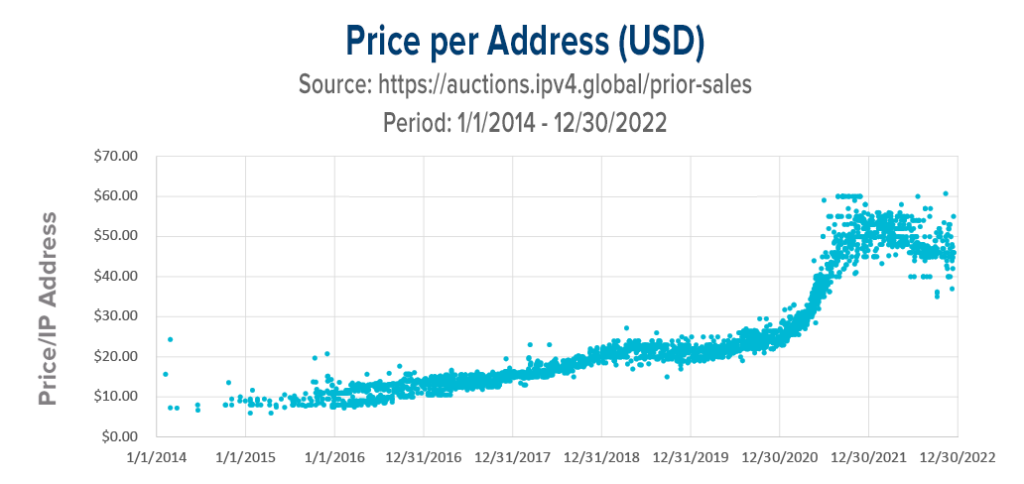
Internet Protocol (IP) is a set of rules for addressing and routing data so it can travel through networks and arrive at its intended destination. Internet-connected devices each have a unique IP address.
In the early development of the internet there appeared to be a virtually unlimited number of IP addresses. The design of the version used in the 1990s – the version still most widely used today – included 4.3 billion addresses. Since the internet was thought to be a research and educational tool, colleges and universities were allocated very large numbers of addresses—free of charge.
Many institutions today have 65,000 or more IPv4 addresses and use a small fraction of them. The surplus is currently valued at approximately $50 each on open markets. So, the holders of these addresses are selling the rights to them in order to finance current needs and long-term projects
Individual IP addresses are unique identifiers most often, but not always, associated with a specific device. Though used one at a time, they are transferred in “blocks” that may include many IP addresses. Possession of a block includes unique registrations of addresses in registries worldwide. These registries maintain uniqueness in the sense that they make sure it’s clear who is the authorized user of a block of IP addresses. Registration includes the ability to transfer IP address use to someone else, subject to the policy of the registries, in return for payment.
What IP Addresses Do
Data traveling on the internet is divided into pieces, called packets. IP information is attached to each packet so that each can arrive in the right place. Almost every location (a device or domain) that connects to the internet is assigned an IP address.
How Data Packets Are Routed
Data packets travel from one machine to another, directed by routers. These read the IP information in each packet and interpret it to send that packet one step closer to its destination. The system relies on each router, including a table of information that correctly determines the next closer route to a packet’s destination.
History
The first major version of IP, Internet Protocol Version 4 (IPv4), is the dominant protocol of the internet. A key benefit of IPv4 is its ease of deployment and widespread use, but a drawback is the limited number of addresses it can define.
Due to the growth of the internet, there aren’t enough IPv4 addresses available for all the devices on the system. Its successor, one that defines more address space, is Internet Protocol Version 6 (IPv6), which was introduced in 2006.
Price History
Due to its design, IPv4 allows for a maximum of 4,294,967,296 unique addresses. At the time of the protocol’s creation, this appeared to be enough for the indefinite future. It was in this spirit that the early internet was modestly managed. Organizations with networks were required to apply for IP addresses, but they were free and readily available. In fact, in the 1980s, a business would simply ask Jon Postel for the addresses it needed. He assigned them and made a note of the assignment in his spiral notebook. In the 1990s and 2000s, a business could get addresses from Regional Internet Registries, which had community-developed policies that defined the requirements for getting a block of the ever-shrinking pool of available addresses.
By 2010 the internet was exploding with new “smart” devices—iPhones, watches, TVs, and even refrigerators with internet capabilities. All of these devices required unique IP addresses. As a result, the supply of IPv4 addresses has become insufficient to describe the location of all the machines on it. IPv6 was created to deal with this problem. The two protocols aren’t perfectly compatible, however, so those with established IPv4 networks have sought additional addresses.

This has created marketplaces where those with a surplus of addresses “sell” or lease them to others. Some growing organizations need more addresses and new organizations may prefer them. Organizations with a surplus can sell or rent any IPv4 addresses they no longer need. The demand for IPv4 addresses has increased dramatically since 2020. Single addresses that exchanged hands for $18 in 2019 were available for as much as $60 in 2022.
Millions of IPv4 addresses are exchanged every year. In 2022, a total of 51,000,000 were traded (not including merger and aquistion transfers). They are bought and sold in lots ranging in size from 256 to 4,194,304 addresses. The exchange involves a number of steps to maintain their singularity of ownership and use. What’s more, markets have been developed for the private and public sale and lease of these assets.
IPv4.Global is the leading online auction site and exchange service for IPv4 addresses worldwide. We consult with and assist buyers and sellers who wish to maintain some privacy in the process.
Hilco teams with E&I to offer participating members help and discounts.

Hilco is a market-leading broker for purchases and sales of IPv4 addresses worldwide. Through the Hilco Streambank contract, E&I members generate revenue through sales of IPv4 address blocks and purchase what they need.